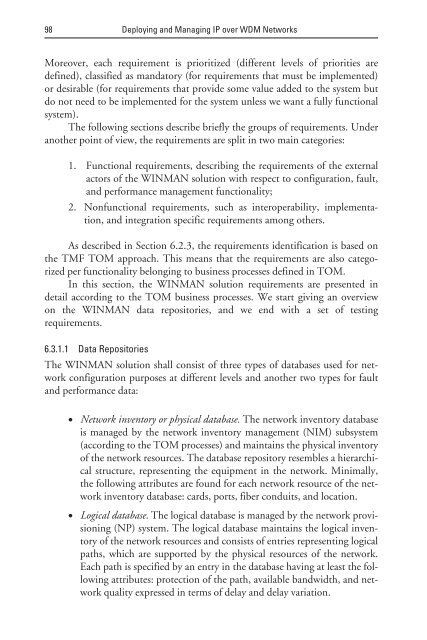deploying and managing ip over wdm networks - Index of
deploying and managing ip over wdm networks - Index of
deploying and managing ip over wdm networks - Index of
You also want an ePaper? Increase the reach of your titles
YUMPU automatically turns print PDFs into web optimized ePapers that Google loves.
98 Deploying <strong>and</strong> Managing IP <strong>over</strong> WDM Networks<br />
More<strong>over</strong>, each requirement is prioritized (different levels <strong>of</strong> priorities are<br />
defined), classified as m<strong>and</strong>atory (for requirements that must be implemented)<br />
or desirable (for requirements that provide some value added to the system but<br />
do not need to be implemented for the system unless we want a fully functional<br />
system).<br />
The following sections describe briefly the groups <strong>of</strong> requirements. Under<br />
another point <strong>of</strong> view, the requirements are split in two main categories:<br />
1. Functional requirements, describing the requirements <strong>of</strong> the external<br />
actors <strong>of</strong> the WINMAN solution with respect to configuration, fault,<br />
<strong>and</strong> performance management functionality;<br />
2. Nonfunctional requirements, such as interoperability, implementation,<br />
<strong>and</strong> integration specific requirements among others.<br />
As described in Section 6.2.3, the requirements identification is based on<br />
the TMF TOM approach. This means that the requirements are also categorized<br />
per functionality belonging to business processes defined in TOM.<br />
In this section, the WINMAN solution requirements are presented in<br />
detail according to the TOM business processes. We start giving an <strong>over</strong>view<br />
on the WINMAN data repositories, <strong>and</strong> we end with a set <strong>of</strong> testing<br />
requirements.<br />
6.3.1.1 Data Repositories<br />
The WINMAN solution shall consist <strong>of</strong> three types <strong>of</strong> databases used for network<br />
configuration purposes at different levels <strong>and</strong> another two types for fault<br />
<strong>and</strong> performance data:<br />
• Network inventory or physical database. The network inventory database<br />
is managed by the network inventory management (NIM) subsystem<br />
(according to the TOM processes) <strong>and</strong> maintains the physical inventory<br />
<strong>of</strong> the network resources. The database repository resembles a hierarchical<br />
structure, representing the equ<strong>ip</strong>ment in the network. Minimally,<br />
the following attributes are found for each network resource <strong>of</strong> the network<br />
inventory database: cards, ports, fiber conduits, <strong>and</strong> location.<br />
• Logical database. The logical database is managed by the network provisioning<br />
(NP) system. The logical database maintains the logical inventory<br />
<strong>of</strong> the network resources <strong>and</strong> consists <strong>of</strong> entries representing logical<br />
paths, which are supported by the physical resources <strong>of</strong> the network.<br />
Each path is specified by an entry in the database having at least the following<br />
attributes: protection <strong>of</strong> the path, available b<strong>and</strong>width, <strong>and</strong> network<br />
quality expressed in terms <strong>of</strong> delay <strong>and</strong> delay variation.


